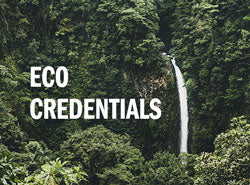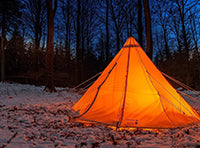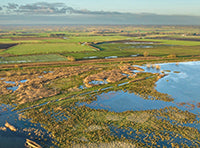Partir à la découverte des collines avec rien d'autre qu'un sac sur le dos suffit à pousser de nombreuses personnes à sortir de leur zone de confort. C'est une bonne chose, mais cela signifie que de nombreux campeurs sauvages craignent d'oublier quelque chose d'essentiel. Et il est vrai que décider de ce qu'il faut emporter pour un camp sauvage peut s'avérer un véritable champ de mines. Pour vous rassurer et vous assurer de ne rien oublier de vital, nous avons établi une liste de matériel de camping sauvage pour vous aider à préparer votre sac à dos comme un pro.
La clé d'un voyage de camping sauvage agréable est de trouver un équilibre entre le poids de votre sac et les articles dont vous avez besoin pour passer une nuit confortable et agréable. Il est conseillé de rassembler tout votre matériel, y compris la nourriture et l'eau, avant de partir. Faites le tour de la maison et montez les escaliers pour vérifier le poids de votre chargement. Soyez vraiment honnête avec vous-même. Si votre sac vous semble lourd lorsque vous montez les escaliers, imaginez le poids qu'il aura si vous faites une longue marche avec de grosses collines à gravir. Si c'est le cas, étalez tout et réfléchissez à ce dont vous avez vraiment besoin et à ce dont vous pourriez vous passer.
Comme vous passerez pas mal de temps à porter votre matériel, un sac à dos peut faire la différence entre un campement sauvage et un campement sauvage agréable. Votre sac à dos doit être suffisamment grand pour contenir tout ce dont vous avez besoin, sans avoir à attacher une charge de matériel à l'extérieur. Le sac lui-même ne doit pas être trop lourd non plus. La dernière chose que vous voulez, c'est de dépenser beaucoup de temps et d'argent pour un équipement léger et de vous rendre compte que c'est justement votre sac à dos qui vous alourdit.
Mais la considération la plus importante lors de l'achat d'un sac à dos est son ajustement. Il est essentiel de choisir le sac qui vous convient. La taille du sac doit être adaptée à la longueur de votre dos. La plupart des sacs à dos de plusieurs jours sont disponibles dans différentes tailles et il existe également des sacs conçus spécialement pour les femmes. Le sac doit être confortable lorsqu'il est chargé. Recherchez un harnais rembourré avec des sangles profilées pour éviter les douleurs aux épaules et une ceinture abdominale de soutien, car vos hanches doivent supporter la plus grande partie du poids. Grâce à la livraison gratuite (à partir de £30) et à notre politique de retour flexible, vous pouvez choisir un sac chez WildBounds et le renvoyer s'il ne vous convient pas.
Vous devez également vous assurer que votre kit reste sec. La plupart des sacs à dos ne sont pas imperméables et, bien qu'ils soient souvent livrés avec des housses, il est rare que celles-ci permettent de garder le contenu du sac complètement au sec. C'est pourquoi nous vous recommandons d'utiliser une doublure de sac à dos ou de placer votre trousse dans des sacs secs. Vous aurez ainsi la certitude de ne pas avoir à dormir dans un sac de couchage détrempé ! Si vous n'avez pas les moyens d'investir dans des sacs secs pour le moment, une bonne astuce consiste à utiliser des sacs à gravats résistants, que l'on peut se procurer dans les magasins de bricolage. Rabattez soigneusement le haut du sac pour empêcher l'eau d'y pénétrer.
À la tombée de la nuit, vous aurez besoin d'un abri. Ce qu'il faut prendre est une question de préférence personnelle. Une tente à double paroi avec un intérieur et un double toit est l'option la plus évidente, ou pour les camps solitaires furtifs, un sac de bivouac est un excellent choix. Si vous vous rendez dans les bois, vous pouvez envisager d'emporter un hamac et une bâche, ou même une petite tente dans les arbres. Les abris ultralégers qui utilisent des bâtons de trekking au lieu de bâtons de tente ou les tentes à peau unique (comme la série Lightwave Sigma ) sont également des options populaires pour le camping sauvage.
Quel que soit l'abri que vous choisirez, vous aurez certainement besoin d'un matelas de couchage isolé et d'un sac de couchage pour rester au chaud toute la nuit. Jetez un coup d'œil aux prévisions météorologiques et voyez jusqu'où la température risque de descendre pendant la nuit afin d'évaluer la chaleur du sac de couchage dont vous aurez besoin. N'oubliez pas que si vous prévoyez de camper en altitude, les conditions seront plus fraîches. Dans des conditions atmosphériques normales, la température de l'air diminue de 1°C à 3°C pour chaque tranche de 300 m de dénivelé. Ainsi, pour le camping sauvage en été dans les collines, un sac deux saisons dont la limite inférieure de température est à un chiffre suffira. Pour le camping au début du printemps et à la fin de l'automne, vous aurez besoin d'un sac trois saisons dont la limite inférieure de température est inférieure à zéro. Pour le camping d'hiver - que nous ne recommandons pas à moins d'être un campeur sauvage expérimenté - vous aurez besoin d'un sac quatre saisons.
N'oubliez pas non plus la valeur d'un matelas de couchage isolé. Il peut vraiment contribuer à augmenter la chaleur. Les matelas reçoivent généralement un indice R, qui évalue la capacité d'un matelas à isoler son utilisateur du sol. Cette isolation est mesurée sur une échelle de 0 à 6. Plus l'indice R est élevé, plus le matelas est chaud.
L'une des joies du camping sauvage est de faire la cuisine en plein air. L'une des idées reçues sur le camping sauvage est que l'on doit se contenter de super nouilles, de pâtes en sauce ou de repas lyophilisés - ce qui n'a rien de répréhensible après une longue journée de marche. Ce n'est pas qu'il y ait quelque chose de mal à cela après une longue journée de marche, mais avec quelques articles supplémentaires, vous pouvez en fait cuisiner une nourriture assez gastronomique.
Cela signifie que vous aurez besoin d'un réchaud de camping léger, d'une marmite et d'un ustensile de cuisine (l'humble fourchette est la meilleure option). Si vous êtes seul, vous pouvez simplement manger dans la casserole, ce qui vous évitera de transporter un bol. Si vous êtes deux, vous pouvez ajouter quelques bols à votre sac. Une boisson chaude, qu'il s'agisse de thé, de café ou de chocolat chaud fumant, est un vrai régal lors d'un camp sauvage, c'est pourquoi nous emportons toujours une tasse.
Si vous prévoyez de cuisiner quelque chose d'un peu plus haut de gamme, un couteau pliant compact est une bonne idée, comme un canif, un couteau de poche ou un couteau suisse. Le James Brand's Ellis est notre compagnon de camping préféré.
Emportez toujours un briquet, des allumettes étanches ou une pierre à feu, même si votre réchaud est à allumage automatique. Les réchauds peuvent être capricieux, et croyez-nous, les rations froides ne sont pas agréables.
Un filtre à eau est également un bon investissement. Si vous avez choisi votre lieu de campement sauvage de manière stratégique, vous avez peut-être une source d'eau naturelle à proximité. Le poids de plusieurs litres d'eau peut s'avérer important, c'est pourquoi il est idéal de disposer d'un ruisseau ou d'un étang à proximité. En filtrant l'eau, vous éliminerez la plupart des insectes et autres nuisances qui s'y cachent. Vous aurez également besoin d'une vessie d'hydratation ou d'une grande bouteille d'eau pour conserver votre eau.
S'il y a une chose que l'on sait à propos du Royaume-Uni, c'est que l'on ne peut jamais compter sur la météo. Ainsi, même si les prévisions annoncent un ciel bleu et un soleil omniprésent, il est préférable d'emporter des vêtements imperméables. Vous devrez porter un pantalon de marche confortable et une couche de base synthétique ou mérinos (pas un t-shirt en coton) qui évacue la transpiration. Il est conseillé d'emporter plusieurs couches, surtout si vous vous rendez dans les collines où les températures peuvent changer rapidement. Une couche intermédiaire telle qu'une polaire en polyester et une veste en duvet ou synthétique à enfiler lorsque vous vous arrêtez sont parfaites. Emportez également des gants et un bonnet: ils vous tiendront chaud au camp et même pendant la nuit si vous avez un peu froid.
Une bonne paire de chaussettes peut faire toute la différence entre une marche agréable et une marche pénible - il n'y a rien de pire que d'avoir des ampoules. Nous emportons toujours des chaussettes de rechange pour le camp également - la dernière chose que vous voulez, c'est que vos pieds soient détrempés pendant la marche, ce qui signifie que vous devez passer la nuit sans chaussettes et remettre des chaussettes humides le lendemain matin.
Les vêtements dans lesquels vous décidez de dormir sont en grande partie une question de préférence personnelle. Certains dormiront en sous-vêtements ou avec leurs couches de base pour la marche. D'autres prendront des pyjamas ou des vêtements de détente confortables. Pour les camps par temps froid, il n'y a rien de mieux que de bonnes couches de base thermiques.
Enfin, portez des chaussures confortables, qu'il s'agisse d'une solide paire de chaussures de randonnée ou de bottes de marche, en fonction du terrain et de votre charge.
Encore une fois, c'est à vous de décider si vous avez besoin de vêtements de rechange pour le matin - c'est vous qui saurez le mieux si vous serez grognon si vous n'avez pas de sous-vêtements propres. Mais vous saurez également si vous êtes du genre à ne pas prendre la peine de changer de vêtements, auquel cas il n'est pas vraiment utile d'en prendre de rechange, car cela ne ferait qu'augmenter le poids à porter.
Nous pensons que c'est là que vous pouvez finir par ajouter beaucoup de poids à votre sac, mais au minimum, vous voudrez probablement prendre une lampe frontale (complètement chargée ou avec des piles neuves), une banque d'énergie portable, une truelle, du papier hygiénique et un sac à fermeture éclair solide pour emporter le rouleau de papier hygiénique usagé. Une petite lanterne de camping peut également s'avérer très utile. Enfin, n'oubliez pas le désinfectant pour les mains et, à moins que vous ne soyez prêt à être vraiment dégoûtant, un petit sac de toilette contenant une brosse à dents et du dentifrice, ainsi que tout ce dont vous avez besoin, comme vos médicaments quotidiens ou vos lentilles de contact.











